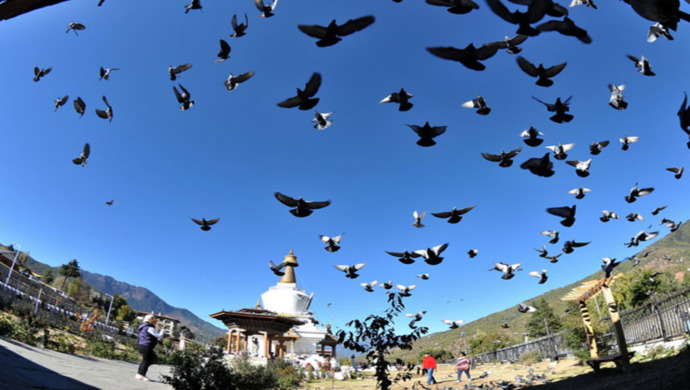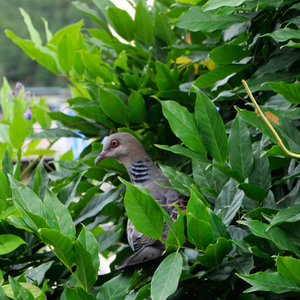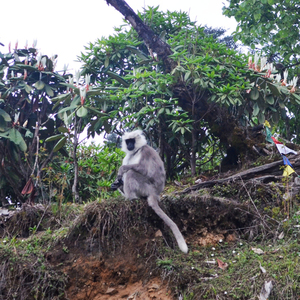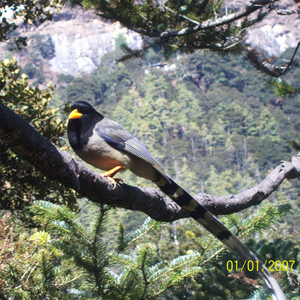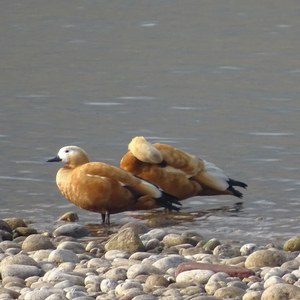Day 1. Arrive Paro/Drive to Thimphu:
Driving Distance: 65 kms, Driving Time: 1.50 hrs – 2 hrs., Altitude of Thimphu: 2350 m.
Your flight to Paro on a clear day, is marked with the panoramic views of the Himalayas including the Everest and other famous Peaks. The approach through the foothills and the landing (including few steep turns) at the tiny airstrip of Paro has been termed as adventurous by many travelers. After the completion of immigration formalities at the Paro Airport exit door, you will be received by your Bhutanese guide with traditional “Tashi Khadar”. Later you are driven to Thimphu and Check in to the hotel. After Lunch, you may relax or go around the Thimphu town and valley – A time for yourself. If you are interested in cycling, you may choose to do so, we shall arrange it for you at an extra cost. Later enjoy a Private traditional cultural show. During the show you could also join in to get a feel of an important aspect of Bhutan.
Meals – Breakfast, Lunch and Dinner; Overnight at the Hotel in Thimphu.
Day 2. Thimphu Sightseeing:
In the morning after your breakfast, drive to the base of Cheri Monastery. And then hike to Cheri Monastery.
- Cheri Monastery, was established in 1620 by Ngawang Namgyal, 1st Zhabdrung Rinpoche. The hike takes about 45 minutes. Apart from being one of the most beautiful monasteries, here we also have an option of meeting with the students and the monks. You would also be see pretty phalluses that are believed to ward of the evil.
You may see Spotted Laughing Thrushes, Chestnut–crowned Laughing Thrushes, White-throated Laughing Thrushes, Rufous-bellied Woodpeckers, Brown Dippers, and White-collared Blackbirds during the hike. In addition, we can see Goral (mountain goat) around the monastery. Drive back to Thimphu. In the afternoon visit the
- Sangaygang View Point, also known as BBS Tower offering panoramic view of Thimphu Town situated at an elevation of 2,685 m.
- Changangkha Monastery, popular fortress like temple perched on a ridge above Central Thimphu built in 15th Century by Lama Phajo Drugom Zhipo.
- Takin Preserve Centre, see Takin (National animal of Bhutan) It is a unique combination of Goat and an Antelope
- Tashichhodzong, or ‘the fortress of the glorious religion’. Initially erected in 1641 by Shabdrung Ngawang Namgyal, it was rebuilt in the 1960s during the reign of Bhutan’s third king in the traditional style, without plans or nails. It houses some ministries, His Majesty’s secretariat, and the central monk body and opens after 5 PM.
Later you return back to the hotel and relax for evening.
Meals – Breakfast, Lunch and Dinner; Overnight at the Hotel in Thimphu.
Day 3. Thimphu - Punakha:
Driving Distance: 76 kms, Driving Time: 2.50 hrs – 3 hrs., Altitude of Punakha: 1310 m.
Early morning and completion of Check Out formalities you are driven to Punakha/Wangdue, for your next leg of the tour. On the way stop at
- Dochula Pass, lies at an elevation of 3,150 m and is a great place to view the higher Himalayas. The landmarks around the pass includes 108 Druk Wangyal Stupas built under the patronage of Queen Ashi Dorji Wangmo Wangchuk.
The mixed forest of hemlock, fir, oak, and rhododendron here is good habitat for many bird species, including: Satyr Tragopans (the bird that draws many birders to the Himalayas), Fire-tailed Myzornis, Rufous-gorgeted Flycatchers, Rufous-breasted Bush Robins, Black-eared Shrike Babblers, and Yellow-billed Blue Magpies. Later, we descend to the Punakha valley, stopping at Lobesa for lunch. In the afternoon, visit the
- Punakha Dzong, built in 1637 by Shabdrung Ngawang Namgyal. For many years until the time of the second King, it served as the seat of the Government. It is still the winter residence of Je-Khenpo (The Chief Abbot of the Central Monastic Body of Bhutan).
- Chhimi Lhakhang, a famous Temple, which is also known as “The Temple of Fertility” built by Lama Drukpa Kuenley.
You are the driven back to the hotel.
Meals – Breakfast, Lunch and Dinner; Overnight at the Hotel in Punakha.
Day 4. Punakha Sightseeing:
For the next two days, we spend the full day birding inside the
- Jigme Dorji National Park, named after the late Jigme Dorji Wangchuk, is the second-largest National Park of Bhutan. It occupies almost the entire Gasa District, as well as the northern areas of Thimphu District, Paro District, Punakha, and Wangdue Phodrang Districts. The park provides sanctuary for 37 known species of mammals It is also home to the Indian leopard and has more than 300 species of birds. Here, we have the potential to see: Red–headed Trogons, Cute Slaty-bellied and Chestnut-headed Tesias, Small Niltavas, Black-chinned Yuhinas, a trio of Forktails, several Wren Babblers, Woodpeckers, Laughing Thrushes, and with luck, Pallas’s Fish Eagles and White-bellied Herons, birds with a population of less than 200 worldwide.
Meals – Breakfast, Lunch and Dinner; Overnight at the Camp or in a hotel.
Day 5. Punakha Sightseeing:
For the next two days, we spend the full day birding inside the
- Jigme Dorji National Park, named after the late Jigme Dorji Wangchuk, is the second-largest National Park of Bhutan. It occupies almost the entire Gasa District, as well as the northern areas of Thimphu District, Paro District, Punakha, and Wangdue Phodrang Districts. The park provides sanctuary for 37 known species of mammals It is also home to the Indian leopard and has more than 300 species of birds. Here, we have the potential to see: Red–headed Trogons, Cute Slaty-bellied and Chestnut-headed Tesias, Small Niltavas, Black-chinned Yuhinas, a trio of Forktails, several Wren Babblers, Woodpeckers, Laughing Thrushes, and with luck, Pallas’s Fish Eagles and White-bellied Herons, birds with a population of less than 200 worldwide.
Meals – Breakfast, Lunch and Dinner; Overnight at the Camp or in a hotel.
Day 6. Punakha - Gangtey / Phobjikha:
Driving Distance: 78 kms, Driving Time: 2.50 hrs – 3 hrs., Altitude of Phobjikha: 2900 m.
Early in the morning, we will start driving to the Phobjikha valley (4 hours), and there will be many birding stops along the way. We will be looking for Ward’s Trogons, Yellow-rumped Honey guides, and other flocks. Before reaching the Pelela pass, we’ll take the side road to the Phobjikha Valley. Crossing the Lawala pass, the vegetation changes into dwarf bamboo, which is good for Laughing Thrushes and Bush Warblers. Once we reach proceed for lunch. Later visit
- Gangtey Goemba, an important monastery of Nyingmapa school of Buddhism, the main seat of the Pema Lingpa tradition. The present Abbot, Kunzang Pema Namgyal is the ninth re-incarnation. It is one of the the largest Nyingma monastery in Bhutan.
In the evening, visit
- Black Necked Crane Information Centre, a place for recreation with crane watching equipment (binoculars, spotting scopes) and reference books.
After the completion of sightseeing, you are driven back to your hotel. After relaxing for some time you are served with dinner.
Meals – Breakfast, Lunch and Dinner; Overnight at the Hotel in Phobjika/Gangtey.
Day 7. Gangtey/Phobjikha - Trongsa:
Driving Distance: 120 kms, Driving Time: 4 hrs – 5 hrs., Altitude of Trongsa: 2300 m
After an early breakfast, we drive to the Pelela pass (4000m). Spend the morning hours birding along the old road at Pelela for the high-altitude species such as Spotted Laughing Thrushes, Himalayan Griffons, Brown Parrot bills, Finches, and Bush Warblers. Continue the drive towards Trongsa. Enroute stop for lunch. In the afternoon, visit the impressive
- Trongsa Dzong, the seat of power over Central and Eastern Bhutan. It was built by Chogyal Minjur Tempa was later enlarged at the end of the 17th century by Desi Tenzin Rabgay. Trongsa Dzong is the ancestral home of the present Royal Family. The first two hereditary kings ruled Bhutan from this Dzong. Even now, it is tradition that any future King of Bhutan must first serve as Governor of Trongsa before the coronation (a form of governance training).
Later, you are driven to the hotel. Evening free for leisure.
Meals – Breakfast, Lunch and Dinner; Overnight at hotel in Trongsa.
Day 8. Trongsa - Zhemgang:
Driving Distance: 115 kms, Driving time: 5 hrs., Altitude of Zhemgang: 1050 m.
Today on our drive to Zhemgang, we will make a number of stops at several forested valleys along the way, where we may see the following birds: Rusty-cheeked Scimitar Babblers, White-browed Scimitar Babblers, Steak-breasted Scimitar Babblers, Grey-bellied Tesias, Crested Buntings, Long-tailed Shrikes, Prinias, Rufous Woodpeckers, Common Green Magpies, Rufous-bellied Eagles, Mountain Hawk Eagles, Common Kestrels, and Minivets. There is also a good chance of sighting the Golden Langur, a leaf monkey endemic to Bhutan.
Meals – Breakfast, Lunch and Dinner; Overnight at the camp.
Day 9. Zhemgang & Tingtibee Road:
For the next two days, we’ll be exploring a wide variety of habitats on the Zhemgang – Tingtibee road. The habitats range from the moss forest to the streamside lowland forest. This is also our best chance to see Bhutan’s endemic Golden Langur leaf monkey, as it is fairly common here. Here, we will be searching for Rufous-necked and Great Hornbills, Pin-tailed Green Pigeons, Cutias, Scarlet Minivets, varieties of Cool Laughing Thrushes, Woodpeckers, Chestnut-headed and Grey-bellied Tesias, Spotted Wren Babblers, and the very rare and sought after Beautiful Nuthatches.
Meals – Breakfast, Lunch and Dinner; Overnight at the camp.
Day 10. Zhemgang & Tingtibee Road:
For the next two days, we’ll be exploring a wide variety of habitats on the Zhemgang – Tingtibee road. The habitats range from the moss forest to the streamside lowland forest. This is also our best chance to see Bhutan’s endemic Golden Langur leaf monkey, as it is fairly common here. Here, we will be searching for Rufous-necked and Great Hornbills, Pin-tailed Green Pigeons, Cutias, Scarlet Minivets, varieties of Cool Laughing Thrushes, Woodpeckers, Chestnut-headed and Grey-bellied Tesias, Spotted Wren Babblers, and the very rare and sought after Beautiful Nuthatches.
Meals – Breakfast, Lunch and Dinner; Overnight at the camp.
Day 11. Zhemgang - Trongsa:
Driving Distance: 115 kms, Driving time: 5 hrs., Altitude of Zhemgang: 1050 m.
After a final round of morning birding, we work our way back to Trongsa, looking for any species we might have missed before. Enroute stop for lunch. In the evening, take some time to explore the town of Trongsa at your leisure.
Meals – Breakfast, Lunch and Dinner; Overnight at the hotel in Trongsa.
Day 12. Trongsa - Thimphu:
Driving Distance: 200 kms, Driving time: 7 hrs - 8 hrs., Altitude of Thimphu: 2350 m.
After breakfast, drive to Thimphu. Enroute stop for lunch. After arrival in Thimphu, check in to the hotel. In the evening free time to relax.
Day 13. Thimphu - Paro:
Driving Distance: 65 kms, Driving time: 1.50 hrs., Altitude of Paro: 2280 m.
After an early breakfast, drive to Paro and then hike to
- Taktsang Monastery (Tiger's nest), the abode of gods and monks situated at an altitude of 3100m on the Upper Paro Valley, Bhutan. As per the legend, Guru Padmasambhana (Guru Rinpoche), the tantrum mystic who brought Buddhism to Bhutan, came in the form of Dorje Droloe riding a flying tigress to subdue the demon that was obstructing the spread of Buddhism in the Himalayas.
After the completion of the hike, you would be served picnic Lunch among the woods. After lunch, visit
- Kyichu Lhakhang, one of the oldest monasteries in Bhutan built in the 7th century by the Tibetan Emperor Songtsen Gampo.
You would then drive to village house to witness the traditional rural life in a Bhutanese village. Also you have an option of experiencing a Traditional Hot Stone bath in the village house. You can also choose to have your dinner in the house with the Family (needed to be confirmed at the of confirmation of tour) or be driven back to your hotel.
Meals – Breakfast, Lunch and Dinner; Overnight at the Hotel in Paro.
Day 14. Paro - Day Excursion to Chele La:
Early in the morning, drive to Chele la pass (3890m).
- Chele la (pass) is considered to be one of the highest motorable passes in Bhutan. The ride passes through lush valleys, pine and rhododendron forest. The pass provides stunning views of the sacred mountain Jomolhari and Jichu Drake. This is a cool Alpine meadow. We should be able to see three different species of Pheasants i.e., colorful Himalayan Monal, Blood Pheasants and Kalij Pheasants. Other birds such as Rose Finches, Grosbeaks, and Laughing Thrushes can also be seen here. Drive back to Paro.
After lunch, visit the
- Paro Rimpung Dzong, also known as Fortress of the heap of jewels, built during the time of Shabdrung Ngawang Namgyal in 1646.
- Ta Dzong, an ancient watch tower overlooking Rimpung Dzong built in 1951 now converted into national museum.
In the evening try the traditional Bhutanese Dress and also try Archery or Khuru.
Meals – Breakfast, Lunch and Dinner; Overnight at the Hotel in Paro.
Day 15. Departure:
Today we will bid farewell to this beautiful country and take an early flight back. We hope by now you must have made some good friends and also have taken photographs and beautiful memories of Bhutan. We certainly hope of serving you again on your next visit to this great country or the Last Shangri-La. Tashi Delek.
